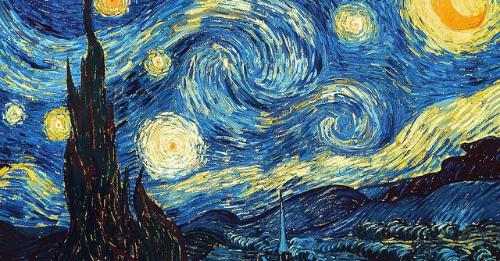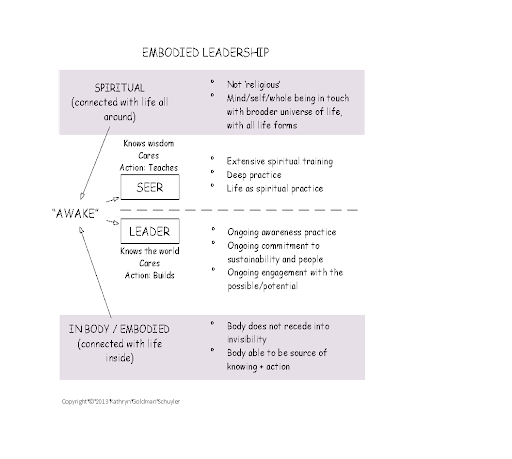What Leaders can learn from Seers

By Kathryn Goldman Schuyler, guest contributor
As the use of what is called “mindfulness” expands in the workplace, I have been reflecting on what mindfulness has meant over the centuries. Although mindfulness-based practices can be used to reduce stress, they have long been intended for more profound purposes. Rather than becoming a “technology” of stress relief, such practices can develop an understanding of interdependence and impermanence. This, in turn, generates compassionate connections with beings around the world. Awareness practice can encourage business and political leaders to take a longer view in making decisions to guide humanity through the systemic challenges we face as a global society.
Two types of leaders have served humanity throughout history:
- Seers or wisdom teachers: Thought and culture leaders steeped in a deep practice of awareness.
- Societal Leaders: Action leaders who guide organizations of all types, developing businesses, shaping government and civil society, and generating innovation.
Humanity and the planet need both! Mindfulness-based practices can make an important contribution to both types of leaders, in differing ways. As we recognize the wisdom aspect of such practices, we may find new ways to incorporate them into leadership development.
Leadership and the Wisdom Traditions
Many cultures throughout history have accorded an important position in society to wisdom teachers, shamans, or wayfinders. We in contemporary Western societies lack a shared terminology for such people. These wisdom teachers or seers come to understand a deeper meaning about the nature of life, usually through some type of ongoing mindfulness or awareness practice.
I have been drawn to, and in search of, such leaders for many decades—really since I was in high school and watched old movies at night on the Late Show with my mother. Two that I recall are The Razor’s Edge (Zanuck and Goulding, 1946) and Lost Horizon (Capra, 1937). Both feature heroes who sought to understand what was truly worthwhile in life. They found teachers who seemed to exist outside of normal time and space and who shared their wisdom with all. After absorbing the teachings, these protagonists returned to their lives transformed, with a deep inner peace and a desire to help others. I continued to search for such teachers in “real” life and finally, after many years, began to find them. For me, they have come from the Tibetan Buddhist tradition, but they exist all over the world in many cultures. They offer what are often described as “wisdom teachings”: teachings, from whatever culture, that focus on the meaning of life, as shared by those who have integrated this wisdom into their daily life.
In my search for wise leaders, I looked for a culture with an approach to values and change that was radically different from my own. I began to study Tibetan Buddhism and how it has been able to survive and thrive in exile. I traveled to Canada and Switzerland to study with the Dalai Lama, seeking to distill what I could about how this view of life can nourish people searching for new perspectives on how to live well. I developed an Embodied Leadership Model (below) to describe what I began to understand about leadership from these experiences.
While seers like the Dalai Lama devote hours to meditative practice and study daily, their goals and focus are different from that of corporate or government executives (“Leaders”), so they need different training. Both the spiritual teacher and executive need deep education in what they will be imparting to others and contributing to the world. The Seers bring traditions of spiritual wisdom, while the Leaders focus on creative development and marketing of products or services that serve humanity and the planet (yes – I realize that not all business is focused on sustainability in this way, but it could be).
They each need to master different things with regard to knowledge and what they do, but both need to care about people and the way their actions impact the planet. I call this embodied leadership to emphasize that we learn and live in bodies: that reflection and action equally are informed by the embodied nature of our existence.
They know and do different things. The leader knows about getting things done by working collaboratively with others and building organizations for greater impact. The seer understands the nature of life and the human heart. Some seers are also leaders, but leaders don’t need (and may not have patience or time for) the depth of spiritual education or training that is required to become a seer.
This diagram of the Embodied Leadership Model illustrates some of the characteristics of the Seer and the Leader roles. The Seer focuses on teaching, while the Leader focuses more on building institutions. Both must be "awake" in the sense of being sensitive to themselves and others. The Seer approaches life more from a spiritual vantage point, based on wisdom engendered by deep practice. The Leader engages more from an "embodied" will to take action in the world. A simplification of this description might be that the Seer engages more from spirit, heart, and mind, and the Leader more from a desire to act in the material world. Neither, however, excludes the other approach.
 What Seers Bring
What Seers Bring
Seers are people whose main focus is wisdom for the sake of all beings. They seek to understand the nature of life and the human mind, not for themselves, but to help other beings. The goal is to share their wisdom in ways that help others appreciate the nature of impermanence, develop compassion for both oneself and others—and appreciate being alive and human.
Seers care deeply for both wisdom and beings. Ideally, they are both kind and wise. Their lives are dedicated to transcending the attachment to self and to helping others to do so, and to seeing daily events in the larger frame from which they as individuals do not matter more than any other individual. Often, they devote considerable time to contemplation and silent retreat.
The Seer embodies a living tradition. In addition to being someone who cares deeply for the well-being of all beings, he or she has been taught a living wisdom by someone who lives this as the core of their nature. Many cultures hold that such wisdom cannot be learned from books. Such traditions only endure as long as there are living beings who can directly and experientially pass on what they know to someone ready to receive it, whether or not it has also been put in writing. It is important to preserve texts where they exist, but the wisdom itself can only be passed from an experienced person to another who is ready to learn.
What Leaders Can Bring
From my experience as a leadership consultant and sociologist, I sense that what business leaders understand, see as feasible, and are able to do depends both on themselves as individuals and on the culture around them. Many are already dedicating their lives to creating products, healthcare, and services to help others thrive. We even see some leaders who understand the importance of changing how humans relate to our planet so that as a species we regenerate life, rather than slowly destroy the future of many species and reduce the capacity of the elements (air, water, earth) to support life.
It’s not so obvious what helps a person to become truly wise and fearless. I don’t think that such a way of being in the world emerges automatically from any particular practices, but requires courage combined with a kind of practical intelligence: a conviction that other beings matter and a capacity to both listen open-heartedly and to get things done. Mindfulness-based practices are one element in such leadership development.
Leaders are and should be focused on performance in a particular setting, but nourished by wisdom. The awareness of self and care for others is in service of secular, organizational goals. Nourishment may come from meditation or contemplation, yet much comes from connections with people and performance. What needs to be mastered is less the wisdom of impermanence and the lack of any real identity for anyone or anything, but more the capacity to bring people together and nourish them in ways that enable them to simultaneously feel valued and perform as needed by the organization.
We need embodied wise leaders at all levels of society throughout the world. The earth and humanity need leaders who can generate new initiatives and develop societal infrastructures that will promote a radical shift of our relationship to our planet in very practical ways. We need more leaders with the practical intelligence and education to master organizational design, manage huge projects, understand financial issues, and who have the specific knowledge and skills of technology, science, or healthcare to create meaningful change. My research and experience suggest that ongoing awareness practices are part of what helps such leaders be present to the people in their organization, to the world and its evolving needs, and to the people who nourish them, including close friends or family.
Implications for the Field of Mindfulness at Work
As the Dalai Lama repeatedly says, “We are all same!” The narrow perception of mindfulness as an individual, private focus can be shifted to an appreciation for collective mindfulness, so that leaders attend to systems and their interdependence. We can explore mindfulness and meditation as social practices that generate awareness of our interconnectedness within the workplace. This becomes a path toward understanding the larger interconnectedness that we as humans have with life itself. It provides ground for growing leaders who lead our local and global societies toward becoming a world that is inclusive and works for all.
This means that what we teach with regard to mindfulness practices may evolve. As our professional mindfulness in the workplace community matures, more experience of the wisdom element may become important for some. A few years of mindfulness practice and deep practical knowledge may make one a great mindfulness facilitator for managers, yet not be sufficient for developing new mindfulness coaches or facilitators. Becoming such a guide may require deeper practice on the path towards being a Seer.
At their best, both Seers and business Leaders have the potential to be embodied leaders: people whose actions emanate from deep convictions, respect for others’ values and cultures, and a unity of head and heart.
Kathryn Goldman Schuyler, Ph.D., is a sociologist, organizational consultant, and educator who supports leaders in moving creatively with awareness through challenging change. Among other publications, she is the author of INNER PEACE—GLOBAL IMPACT: Tibetan Buddhism, Leadership, and Work (IAP-2012) and editor of Creative Social Change: Leadership for a Healthy World (Emerald, 2016).
This article is loosely based on Kathryn’s article “Mindfulness as Waking Up: Musings about How to be Optimally Alive”, published in the Journal of Corporate Citizenship, 62, 59-75, DOI: [10.9774/GLEAF.4700.2016.ju.000010].

2 comments
To me a commitment to mindfulness is dedicating oneself to a the spiritual journey of ego transcendence. A nondual journey that is grounded in the recognition of the fundamental dignity of all sentient beings. In this place, although it may manifest differently, there is no distinction between seer and leader.
Finally, someone is addressing essential workplace issues with a different twist. Clearly, Dr Goldman Schuyler has devoted considerable time and tremendous energy to the study and understanding of Awareness in the workplace.
Her “out of the box” ways of identifying issues and providing creative solutions in this article are completely refreshing. I also gained much insight from her book, Creative Social Change: Leadership for a Healthy World in which anecdotal short chapters and interviews with major players in the field of innovative leadership make for readable, interesting and relevant content.
Leave a comment